微分方程(differential equations)
- 格式:ppt
- 大小:411.00 KB
- 文档页数:27
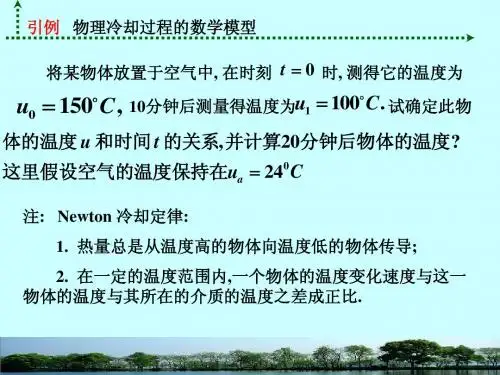
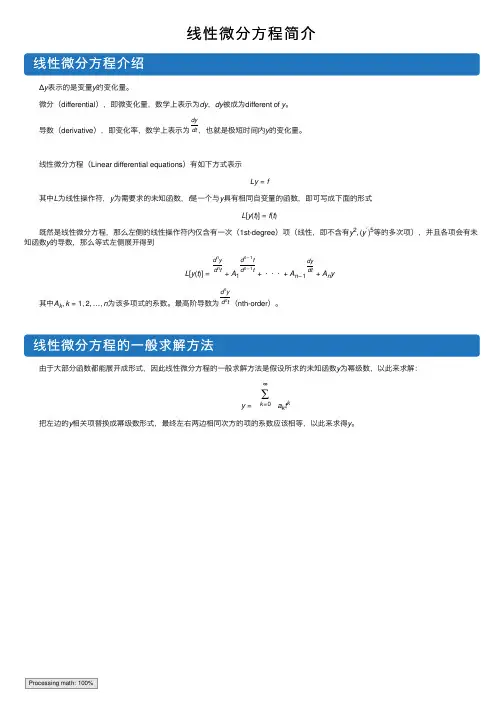
线性微分⽅程简介
Δy表⽰的是变量y的变化量。
微分(differential),即微变化量,数学上表⽰为dy,dy被成为different of y。
导数(derivative),即变化率,数学上表⽰为dy
dt,也就是极短时间内y的变化量。
线性微分⽅程(Linear differential equations)有如下⽅式表⽰
Ly=f
其中L为线性操作符,y为需要求的未知函数,f是⼀个与y具有相同⾃变量的函数,即可写成下⾯的形式
L[y(t)]=f(t)
既然是线性微分⽅程,那么左侧的线性操作符内仅含有⼀次(1st-degree)项(线性,即不含有y2,(y′)5等的多次项),并且各项会有未知函数y的导数,那么等式左侧展开得到
L[y(t)]=d n y
d n t+A
1
d n−1t
d n−1t+⋅⋅⋅+A
n−1
dy
dt+A
n y
其中A k,k=1,2,…,n为该多项式的系数。
最⾼阶导数为d n y
d n t(nth-order)。
由于⼤部分函数都能展开成形式,因此线性微分⽅程的⼀般求解⽅法是假设所求的未知函数y为幂级数,以此来求解:
y=
∞
∑
k=0a k t k
把左边的y相关项替换成幂级数形式,最终左右两边相同次⽅的项的系数应该相等,以此来求得y。
Processing math: 100%。
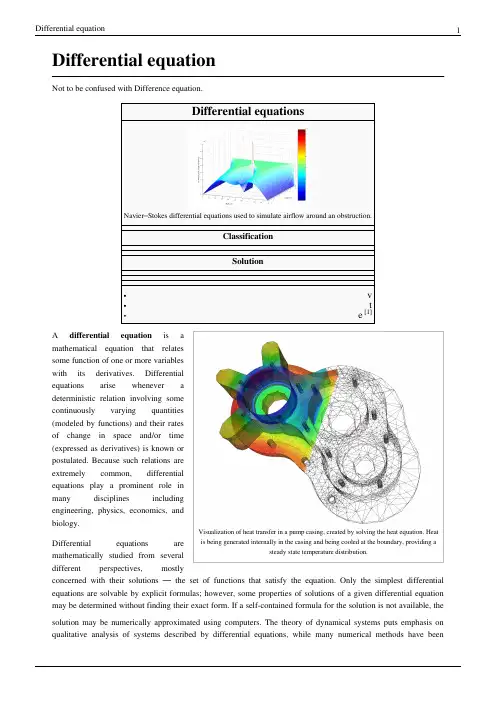
Differential equationNot to be confused with Difference equation.Stokes differential equations used to simulate airflow around an obstruction.ClassificationSolutionVisualization of heat transfer in a pump casing, created by solving the heat equation. Heat is being generated internally in the casing and being cooled at the boundary, providing a steady state temperature distribution.A differential equation is amathematical equation that relatessome function of one or more variableswith its derivatives. Differentialequations arise whenever adeterministic relation involving somecontinuously varying quantities(modeled by functions) and their ratesof change in space and/or time(expressed as derivatives) is known orpostulated. Because such relations areextremely common, differentialequations play a prominent role inmany disciplines includingengineering, physics, economics, andbiology.Differential equations aremathematically studied from severaldifferent perspectives, mostlyconcerned with their solutions — the set of functions that satisfy the equation. Only the simplest differential equations are solvable by explicit formulas; however, some properties of solutions of a given differential equation may be determined without finding their exact form. If a self-contained formula for the solution is not available, the solution may be numerically approximated using computers. The theory of dynamical systems puts emphasis on qualitative analysis of systems described by differential equations, while many numerical methods have beendeveloped to determine solutions with a given degree of accuracy.ExampleFor example, in classical mechanics, the motion of a body is described by its position and velocity as the time value varies. Newton's laws allow one (given the position, velocity, acceleration and various forces acting on the body) to express these variables dynamically as a differential equation for the unknown position of the body as a function of time.In some cases, this differential equation (called an equation of motion) may be solved explicitly.An example of modelling a real world problem using differential equations is the determination of the velocity of a ball falling through the air, considering only gravity and air resistance. The ball's acceleration towards the ground is the acceleration due to gravity minus the acceleration due to air resistance. Gravity is considered constant, and air resistance may be modeled as proportional to the ball's velocity. This means that the ball's acceleration, which is a derivative of its velocity, depends on the velocity (and the velocity depends on time). Finding the velocity as a function of time involves solving a differential equation and verifying its validity.Directions of studyThe study of differential equations is a wide field in pure and applied mathematics, physics, and engineering. All of these disciplines are concerned with the properties of differential equations of various types. Pure mathematics focuses on the existence and uniqueness of solutions, while applied mathematics emphasizes the rigorous justification of the methods for approximating solutions. Differential equations play an important role in modelling virtually every physical, technical, or biological process, from celestial motion, to bridge design, to interactions between neurons. Differential equations such as those used to solve real-life problems may not necessarily be directly solvable, i.e. do not have closed form solutions. Instead, solutions can be approximated using numerical methods.Mathematicians also study weak solutions (relying on weak derivatives), which are types of solutions that do not have to be differentiable everywhere. This extension is often necessary for solutions to exist.The study of the stability of solutions of differential equations is known as stability theory.NomenclatureThe theory of differential equations is well developed and the methods used to study them vary significantly with the type of the equation.Ordinary and partial•An ordinary differential equation (ODE) is a differential equation in which the unknown function (also known as the dependent variable) is a function of a single independent variable. In the simplest form, the unknown function is a real or complex valued function, but more generally, it may be vector-valued or matrix-valued: this corresponds to considering a system of ordinary differential equations for a single function.Ordinary differential equations are further classified according to the order of the highest derivative of the dependent variable with respect to the independent variable appearing in the equation. The most important cases for applications are first-order and second-order differential equations. For example, Bessel's differential equation(in which y is the dependent variable) is a second-order differential equation. In the classical literature a distinction is also made between differential equations explicitly solved with respect to the highest derivative and differential equations in an implicit form. Also important is the degree, or (highest) power, of the highest derivative(s) in the equation (cf. : degree of a polynomial). A differential equation is called a nonlinear differential equation if its degree is not one (a sufficient but unnecessary condition).• A partial differential equation (PDE) is a differential equation in which the unknown function is a function of multiple independent variables and the equation involves its partial derivatives. The order is defined similarly to the case of ordinary differential equations, but further classification into elliptic, hyperbolic, and parabolic equations, especially for second-order linear equations, is of utmost importance. Some partial differentialequations do not fall into any of these categories over the whole domain of the independent variables and they are said to be of mixed type.Linear and non-linearBoth ordinary and partial differential equations are broadly classified as linear and nonlinear.• A differential equation is linear if the unknown function and its derivatives appear to the power 1 (products of the unknown function and its derivatives are not allowed) and nonlinear otherwise. The characteristic property of linear equations is that their solutions form an affine subspace of an appropriate function space, which results in much more developed theory of linear differential equations. Homogeneous linear differential equations are a further subclass for which the space of solutions is a linear subspace i.e. the sum of any set of solutions or multiples of solutions is also a solution. The coefficients of the unknown function and its derivatives in a linear differential equation are allowed to be (known) functions of the independent variable or variables; if these coefficients are constants then one speaks of a constant coefficient linear differential equation.•There are very few methods of solving nonlinear differential equations exactly; those that are known typically depend on the equation having particular symmetries. Nonlinear differential equations can exhibit verycomplicated behavior over extended time intervals, characteristic of chaos. Even the fundamental questions of existence, uniqueness, and extendability of solutions for nonlinear differential equations, and well-posedness of initial and boundary value problems for nonlinear PDEs are hard problems and their resolution in special cases is considered to be a significant advance in the mathematical theory (cf. Navier–Stokes existence and smoothness).However, if the differential equation is a correctly formulated representation of a meaningful physical process, then one expects it to have a solution.Linear differential equations frequently appear as approximations to nonlinear equations. These approximations are only valid under restricted conditions. For example, the harmonic oscillator equation is an approximation to the nonlinear pendulum equation that is valid for small amplitude oscillations (see below).ExamplesIn the first group of examples, let u be an unknown function of x, and c and ω are known constants.•Inhomogeneous first-order linear constant coefficient ordinary differential equation:•Homogeneous second-order linear ordinary differential equation:•Homogeneous second-order linear constant coefficient ordinary differential equation describing the harmonic oscillator:•Inhomogeneous first-order nonlinear ordinary differential equation:•Second-order nonlinear (due to sine function) ordinary differential equation describing the motion of a pendulum of length L:In the next group of examples, the unknown function u depends on two variables x and t or x and y.•Homogeneous first-order linear partial differential equation:•Homogeneous second-order linear constant coefficient partial differential equation of elliptic type, the Laplace equation:•Third-order nonlinear partial differential equation, the Korteweg–de Vries equation:Related concepts• A delay differential equation (DDE) is an equation for a function of a single variable, usually called time, in which the derivative of the function at a certain time is given in terms of the values of the function at earlier times.• A stochastic differential equation (SDE) is an equation in which the unknown quantity is a stochastic process and the equation involves some known stochastic processes, for example, the Wiener process in the case of diffusion equations.• A differential algebraic equation (DAE) is a differential equation comprising differential and algebraic terms, given in implicit form.Connection to difference equationsSee also: Time scale calculusThe theory of differential equations is closely related to the theory of difference equations, in which the coordinates assume only discrete values, and the relationship involves values of the unknown function or functions and values at nearby coordinates. Many methods to compute numerical solutions of differential equations or study the properties of differential equations involve approximation of the solution of a differential equation by the solution of a corresponding difference equation.Universality of mathematical descriptionMany fundamental laws of physics and chemistry can be formulated as differential equations. In biology and economics, differential equations are used to model the behavior of complex systems. The mathematical theory of differential equations first developed together with the sciences where the equations had originated and where the results found application. However, diverse problems, sometimes originating in quite distinct scientific fields, may give rise to identical differential equations. Whenever this happens, mathematical theory behind the equations can be viewed as a unifying principle behind diverse phenomena. As an example, consider propagation of light and sound in the atmosphere, and of waves on the surface of a pond. All of them may be described by the same second-order partial differential equation, the wave equation, which allows us to think of light and sound as forms of waves, much like familiar waves in the water. Conduction of heat, the theory of which was developed by Joseph Fourier, is governed by another second-order partial differential equation, the heat equation. It turns out that many diffusion processes, while seemingly different, are described by the same equation; the Black–Scholes equation in finance is, for instance, related to the heat equation.Notable differential equationsPhysics and engineering•Newton's Second Law in dynamics (mechanics)•Euler–Lagrange equation in classical mechanics•Hamilton's equations in classical mechanics•Radioactive decay in nuclear physics•Newton's law of cooling in thermodynamics•The wave equation•Maxwell's equations in electromagnetism•The heat equation in thermodynamics•Laplace's equation, which defines harmonic functions•Poisson's equation•Einstein's field equation in general relativity•The Schrödinger equation in quantum mechanics•The geodesic equation•The Navier–Stokes equations in fluid dynamics•The Diffusion equation in stochastic processes•The Convection–diffusion equation in fluid dynamics•The Cauchy–Riemann equations in complex analysis•The Poisson–Boltzmann equation in molecular dynamics•The shallow water equations•Universal differential equation•The Lorenz equations whose solutions exhibit chaotic flow.Biology•Verhulst equation – biological population growth•von Bertalanffy model – biological individual growth•Lotka–Volterra equations – biological population dynamics•Replicator dynamics – found in theoretical biology•Hodgkin–Huxley model – neural action potentialsEconomics•The Black–Scholes PDE•Exogenous growth model•Malthusian growth model•The Vidale–Wolfe advertising modelReferences•P. Abbott and H. Neill, Teach Yourself Calculus, 2003 pages 266-277•P. Blanchard, R. L. Devaney, G. R. Hall, Differential Equations, Thompson, 2006• E. A. Coddington and N. Levinson, Theory of Ordinary Differential Equations, McGraw-Hill, 1955• E. L. Ince, Ordinary Differential Equations, Dover Publications, 1956•W. Johnson, A Treatise on Ordinary and Partial Differential Equations[2], John Wiley and Sons, 1913, in University of Michigan Historical Math Collection [3]• A. D. Polyanin and V. F. Zaitsev, Handbook of Exact Solutions for Ordinary Differential Equations (2nd edition), Chapman & Hall/CRC Press, Boca Raton, 2003. ISBN 1-58488-297-2.•R. I. Porter, Further Elementary Analysis, 1978, chapter XIX Differential Equations•Teschl, Gerald (2012). Ordinary Differential Equations and Dynamical Systems[4]. Providence: American Mathematical Society. ISBN 978-0-8218-8328-0.• D. Zwillinger, Handbook of Differential Equations (3rd edition), Academic Press, Boston, 1997.[1]/w/index.php?title=Template:Differential_equations&action=edit[2]/cgi/b/bib/bibperm?q1=abv5010.0001.001[3]/u/umhistmath/[4]http://www.mat.univie.ac.at/~gerald/ftp/book-ode/External links•Lectures on Differential Equations (/courses/mathematics/18-03-differential-equations-spring-2010/video-lectures/) MIT Open CourseWare Videos•Online Notes / Differential Equations (/classes/de/de.aspx) Paul Dawkins, Lamar University•Differential Equations (/diffeq/diffeq.html), S.O.S. Mathematics•Differential Equation Solver (/tools/differential_equation_solver/) Java applet tool used to solve differential equations.•Introduction to modeling via differential equations (/mat/u-u/en/ differential_equations_intro.htm) Introduction to modeling by means of differential equations, with critical remarks.•Mathematical Assistant on Web (http://user.mendelu.cz/marik/maw/index.php?lang=en&form=ode) Symbolic ODE tool, using Maxima•Exact Solutions of Ordinary Differential Equations (http://eqworld.ipmnet.ru/en/solutions/ode.htm)•Collection of ODE and DAE models of physical systems (/research/models.htm) MATLAB models•Notes on Diffy Qs: Differential Equations for Engineers (/diffyqs/) An introductory textbook on differential equations by Jiri Lebl of UIUC•Khan Academy Video playlist on differential equations (/math/ differential-equations) Topics covered in a first year course in differential equations.•MathDiscuss Video playlist on differential equations (/category/courses/ solutions-differential-equations/homogeneous-linear-systems/)Article Sources and Contributors8Article Sources and ContributorsDifferential equation Source: /w/index.php?oldid=610771276 Contributors: 17Drew, After Midnight, Ahoerstemeier, Alarius, Alfred Centauri, Amahoney, AndreiPolyanin, Andres, AndrewHowse, Andycjp, Andytalk, AngryPhillip, Anonymous Dissident, Antoni Barau, Antonius Block, Anupam, Apmonitor, Arcfrk, Asdf39, Asyndeton, Attilios,Babayagagypsies, Baccala@, Baccyak4H, Bejohns6, Bento00, Berland, Bidabadi, Bigusbry, BillyPreset, Bob.v.R, Bolatbek, Brandon, Bryanmcdonald, Btyner, Bygeorge2512,Callumds, Charles Matthews, Christian75, Chtito, Cispyre, Cmprince, Coginsys, ConMan, Cxz111, Cybercobra, DAJF, Danski14, Dbroadwell, Ddxc, Delaszk, DerHexer, Dewritech, Difu Wu, Djordjes, DominiqueNC, Donludwig, Dpv, Dr sarah madden, Drmies, DroEsperanto, Duoduoduo, Dysprosia, EconoPhysicist, Elwikipedista, Epicgenius, EricBright, Erin.Annette.Brown,Estudiarme, F=q(E+v^B), Fintor, Fioravante Patrone, Fioravante Patrone en, Flameturtle, Friend of the Facts, FutureTrillionaire, Gabrielleitao, Gandalf61, Gauss, Genedronek, Geni, Giftlite,GoingBatty, Gombang, Grenavitar, Haham hanuka, Hamiltondaniel, Harry, Haruth, Haseeb Jamal, Heikki m, Holmes1900, Ilya Voyager, Iquseruniv, Iulianu, Izodman2012, J arino, J.delanoy, Ja 62, Jak86, JamesBWatson, Jao, Jarble, Jauhienij, Jayden54, Jeancey, Jersey Devil, Jim Sukwutput, Jim.belk, Jim.henderson, JinJian, Jitse Niesen, JohnOwens, Johndoeisnotmyname, JorisvS,Julesd, K-UNIT, Kayvan45622, KeithJonsn, Kensaii, Khalid Mahmood, Klaas van Aarsen, Kr5t, Krushia, LOL, Lambiam, Lavateraguy, Lethe, LibLord, Linas, Lumos3, Madmath789, Mandarax, Mankarse, MarSch, Martastic, Martynas Patasius, Maschen, Math.geek3.1415926, Matqkks, Mattmnelson, Maurice Carbonaro, Maxis ftw, Mazi, McVities, Mduench, Mets501, Mh, MichaelHardy, Mindspillage, MisterSheik, Mohan1986, Mossaiby, Mpatel, MrOllie, Mtness, Mysidia, Nik-renshaw, Nkayesmith, Norm mit, Okopecz, Oleg Alexandrov, Opelio, Pahio, Parusaro, Paul August, Paul Matthews, Paul Richter, PavelSolin, Pgk, Phoebe, Pine, Pinethicket, Pratyya Ghosh, PseudoSudo, Qwerty Binary, Qzd800, R'n'B, Rama's Arrow, Randomguess, Reallybored999, RexNL, Reyk, RichMorin, Robin S, Romansanders, Rosasco, Ruakh, SDC, SFC9394, SakeUPenn, Salix alba, Sam Staton, Sampathsris, Sardanaphalus, Senoreuchrestud, Silly rabbit, Siroxo,Skakkle, Skypher, SmartPatrol, Snowjeep, Spirits in the Material, Starwiz, Suffusion of Yellow, Sverdrup, Symane, TVBZ28, TYelliot, Tannkrem, Tbhotch, Tbsmith, TexasAndroid, Tgeairn, The Hybrid, The Thing That Should Not Be, Timelesseyes, Tranum1234567890, Tsirel, Tuseroni, User A1, Vanished User 0001, Vishwanathnm, Vthiru, Waffleguy4, Waldir, Waltpohl, Wavelength, Wclxlus, Wihenao, Willtron, Winterheart, Wsears, XJaM, Yafujifide, Zepterfd, ﺪﺟﺎﺳ ﺪﺠﻣﺍ ﺪﺟﺎﺳ, 363 anonymous editsImage Sources, Licenses and ContributorsFile:Airflow-Obstructed-Duct.png Source: /w/index.php?title=File:Airflow-Obstructed-Duct.png License: Public Domain Contributors: Original uploader was User A1 at en.wikipediaFile:Elmer-pump-heatequation.png Source: /w/index.php?title=File:Elmer-pump-heatequation.png License: Creative Commons Attribution-Sharealike 3.0Contributors: Christian1985, Crimerob, Kri, User A1, 2 anonymous editsLicenseCreative Commons Attribution-Share Alike 3.0///licenses/by-sa/3.0/。
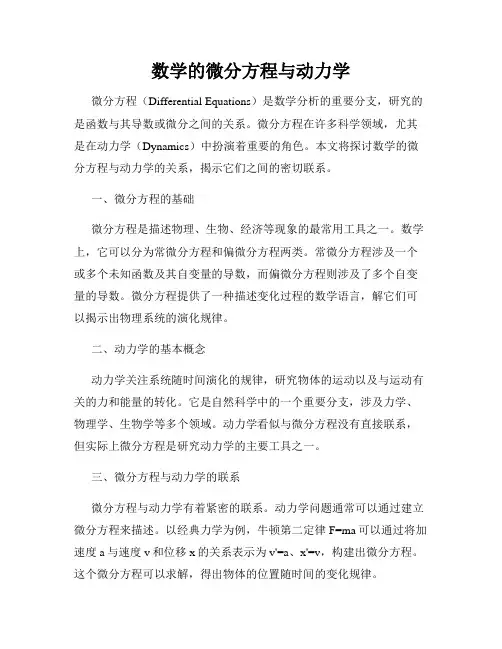
数学的微分方程与动力学微分方程(Differential Equations)是数学分析的重要分支,研究的是函数与其导数或微分之间的关系。
微分方程在许多科学领域,尤其是在动力学(Dynamics)中扮演着重要的角色。
本文将探讨数学的微分方程与动力学的关系,揭示它们之间的密切联系。
一、微分方程的基础微分方程是描述物理、生物、经济等现象的最常用工具之一。
数学上,它可以分为常微分方程和偏微分方程两类。
常微分方程涉及一个或多个未知函数及其自变量的导数,而偏微分方程则涉及了多个自变量的导数。
微分方程提供了一种描述变化过程的数学语言,解它们可以揭示出物理系统的演化规律。
二、动力学的基本概念动力学关注系统随时间演化的规律,研究物体的运动以及与运动有关的力和能量的转化。
它是自然科学中的一个重要分支,涉及力学、物理学、生物学等多个领域。
动力学看似与微分方程没有直接联系,但实际上微分方程是研究动力学的主要工具之一。
三、微分方程与动力学的联系微分方程与动力学有着紧密的联系。
动力学问题通常可以通过建立微分方程来描述。
以经典力学为例,牛顿第二定律F=ma可以通过将加速度a与速度v和位移x的关系表示为v'=a、x'=v,构建出微分方程。
这个微分方程可以求解,得出物体的位置随时间的变化规律。
四、微分方程在动力学中的应用微分方程在动力学中被广泛应用。
在经济学中,微分方程可以用来描述市场供需关系的变化;在生物学中,微分方程可以用来描述生物种群的增长和衰减规律;在物理学中,微分方程可以用来描述电路中电流和电压的变化。
五、数值解法与动力学仿真微分方程通常难以直接求解,因此数值解法和动力学仿真成为解决微分方程问题的重要手段。
数值解法通过将微分方程转化为差分方程,离散化求解得到近似解;而动力学仿真则通过模拟系统的演化过程,得到系统的行为和发展趋势。
六、微分方程与混沌理论混沌理论是动力学的一个重要分支,研究的是非线性系统中表现出的复杂行为。
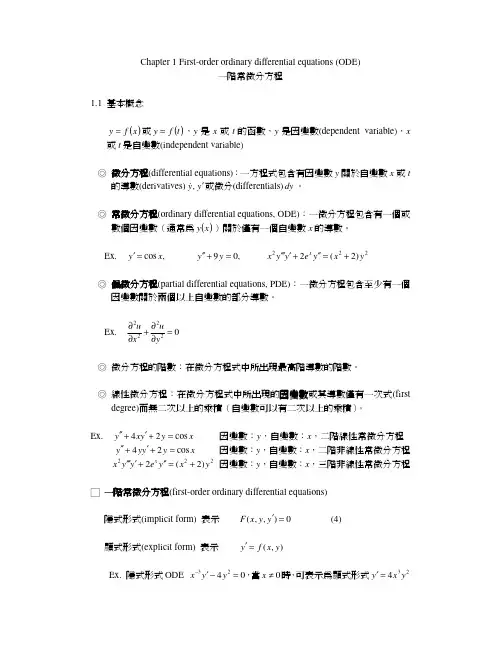
Chapter 1 First-order ordinary differential equations (ODE)一階常微分方程1.1 基本概念()x f y =或()t f y =,y 是x 或t 的函數,y 是因變數(dependent variable ),x 或t 是自變數(independent variable )◎ 微分方程(differential equations):一方程式包含有因變數y 關於自變數x 或t的導數(derivatives)y y ′ ,&或微分(differentials)dy 。
◎ 常微分方程(ordinary differential equations, ODE):一微分方程包含有一個或數個因變數(通常為()x y )關於僅有一個自變數x 的導數。
Ex. 222)2(2 ,09 ,cos y x y e y y x y y x y x +=′′+′′′′=+′′=′◎ 偏微分方程(partial differential equations, PDE):一微分方程包含至少有一個因變數關於兩個以上自變數的部分導數。
Ex. 02222=∂∂+∂∂yux u◎ 微分方程的階數:在微分方程式中所出現最高階導數的階數。
◎ 線性微分方程:在微分方程式中所出現的因變數因變數因變數或其導數僅有一次式(first degree)而無二次以上的乘積(自變數可以有二次以上的乘積)。
Ex. x y y x y cos 24=+′+′′ 因變數:y ,自變數:x ,二階線性常微分方程 x y y y y cos 24=+′+′′ 因變數:y ,自變數:x ,二階非線性常微分方程 222)2(2 y x y e y y x x +=′′+′′′′ 因變數:y ,自變數:x ,三階非線性常微分方程□ 一階常微分方程(first-order ordinary differential equations)隱式形式(implicit form) 表示 0),,(=′y y x F (4)顯式形式(explicit form) 表示 ),(y x f y =′Ex. 隱式形式ODE 0423=−′−y y x ,當0≠x 時,可表示為顯式形式234y x y =′□ 解的概念(concept of solution)在某些開放間隔區間b x a <<,一函數)(x h y =是常微分方程常微分方程0),,(=′y y x F 的解,其函數)(x h 在此區間b x a <<是明確(defined)且可微分的(differentiable),其)(x h 的曲線(或圖形)是被稱為解答曲線(solution curve)。
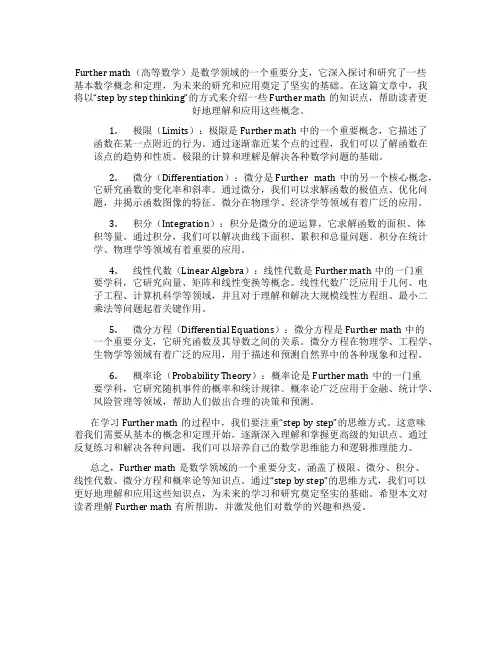
Further math(高等数学)是数学领域的一个重要分支,它深入探讨和研究了一些基本数学概念和定理,为未来的研究和应用奠定了坚实的基础。
在这篇文章中,我将以“step by step thinking”的方式来介绍一些Further math的知识点,帮助读者更好地理解和应用这些概念。
1.极限(Limits):极限是Further math中的一个重要概念,它描述了函数在某一点附近的行为。
通过逐渐靠近某个点的过程,我们可以了解函数在该点的趋势和性质。
极限的计算和理解是解决各种数学问题的基础。
2.微分(Differentiation):微分是Further math中的另一个核心概念,它研究函数的变化率和斜率。
通过微分,我们可以求解函数的极值点、优化问题,并揭示函数图像的特征。
微分在物理学、经济学等领域有着广泛的应用。
3.积分(Integration):积分是微分的逆运算,它求解函数的面积、体积等量。
通过积分,我们可以解决曲线下面积、累积和总量问题。
积分在统计学、物理学等领域有着重要的应用。
4.线性代数(Linear Algebra):线性代数是Further math中的一门重要学科,它研究向量、矩阵和线性变换等概念。
线性代数广泛应用于几何、电子工程、计算机科学等领域,并且对于理解和解决大规模线性方程组、最小二乘法等问题起着关键作用。
5.微分方程(Differential Equations):微分方程是Further math中的一个重要分支,它研究函数及其导数之间的关系。
微分方程在物理学、工程学、生物学等领域有着广泛的应用,用于描述和预测自然界中的各种现象和过程。
6.概率论(Probability Theory):概率论是Further math中的一门重要学科,它研究随机事件的概率和统计规律。
概率论广泛应用于金融、统计学、风险管理等领域,帮助人们做出合理的决策和预测。
在学习Further math的过程中,我们要注重“step by step”的思维方式。
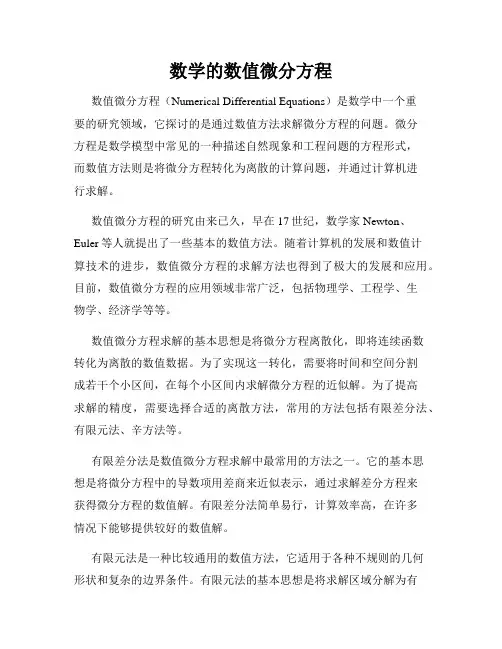
数学的数值微分方程数值微分方程(Numerical Differential Equations)是数学中一个重要的研究领域,它探讨的是通过数值方法求解微分方程的问题。
微分方程是数学模型中常见的一种描述自然现象和工程问题的方程形式,而数值方法则是将微分方程转化为离散的计算问题,并通过计算机进行求解。
数值微分方程的研究由来已久,早在17世纪,数学家Newton、Euler等人就提出了一些基本的数值方法。
随着计算机的发展和数值计算技术的进步,数值微分方程的求解方法也得到了极大的发展和应用。
目前,数值微分方程的应用领域非常广泛,包括物理学、工程学、生物学、经济学等等。
数值微分方程求解的基本思想是将微分方程离散化,即将连续函数转化为离散的数值数据。
为了实现这一转化,需要将时间和空间分割成若干个小区间,在每个小区间内求解微分方程的近似解。
为了提高求解的精度,需要选择合适的离散方法,常用的方法包括有限差分法、有限元法、辛方法等。
有限差分法是数值微分方程求解中最常用的方法之一。
它的基本思想是将微分方程中的导数项用差商来近似表示,通过求解差分方程来获得微分方程的数值解。
有限差分法简单易行,计算效率高,在许多情况下能够提供较好的数值解。
有限元法是一种比较通用的数值方法,它适用于各种不规则的几何形状和复杂的边界条件。
有限元法的基本思想是将求解区域分解为有限个几何单元,通过对每个单元的逼近来得到整个区域的逼近解。
有限元法具有较高的逼近精度和灵活性,适用于一些复杂的物理问题。
辛方法是一种用于保持哈密顿系统能量守恒的数值方法,它在模拟长时间演化的系统中表现出了出色的稳定性和长期保持能量守恒的特点。
辛方法广泛应用于天体力学、分子动力学等领域的模拟计算中。
除了以上提到的方法,还有一些其他的数值方法,如龙格-库塔法、多步法、多项式插值法等,它们在不同的问题和应用中具有各自的优势和适用范围。
总之,数值微分方程是数学中重要的研究内容,通过数值方法求解微分方程可以有效地获得问题的数值解。

微分方程解法总结微分方程(DifferentialEquations)是数学中一类重要的运筹学问题,也是许多应用数学领域中最重要的数学工具之一。
微分方程可以应用在物理学、化学、工程学、生物学及经济学等学科中,在多学科领域中都发挥了重要作用。
一般来说,微分方程可以用一组方程来描述某种函数的变化,其中包括两个或更多的未知函数。
常用的微分方程解法包括,比如直接法、可积性法、积分变换法等。
1.接法直接法是指从微分方程的定义出发,直接寻找微分方程的解的方法。
一般来说,将定义域上的某个变量作为一个变量来代替原方程中的其它变量,从而将原方程变为一个关于这个变量的微分方程,再解此新的微分方程,最终得到需要的解。
2.积性法可积性法,即牛顿-拉夫逊定理,是指依据微分方程中的微分操作,运用积分学手段求出微分方程的解的方法。
牛顿-拉夫逊定理具有很强的通用性,几乎可以用于解决所有的不定积分问题,而且可以在多个变量之间进行推导。
3.分变换法积分变换法是一种特殊的可积性法,通过运用微积分中的奇偶变换,由傅里叶变换求出微分方程的解。
这种方法主要用于解决有限区间上的微分方程,既可以解决常规的微分方程,也可以解决非线性微分方程。
4.值方法数值方法是指用计算机从解析计算的角度进行微分方程的解法。
数值方法可分为两类,一类是有限差分的方法,另一类是可积性方法。
有限差分方法是在有限域上利用数值误差求解微分方程,它主要用于解决常微分方程组和椭圆型方程;可积性方法是指基于可积性定理,将微分方程转变为积分形式,再采用计算机数值解法,求出积分方程的解的方法。
总之,上述四类解法分别具有自己的优势和不足,因此要采取最适合的方式来解决某一类微分方程。
此外,在进行解微分方程的过程中,要进行精确的数学推导,以确保最终得到的解析解是准确可靠的。
通过上述分析,可以清楚地了解微分方程解法。
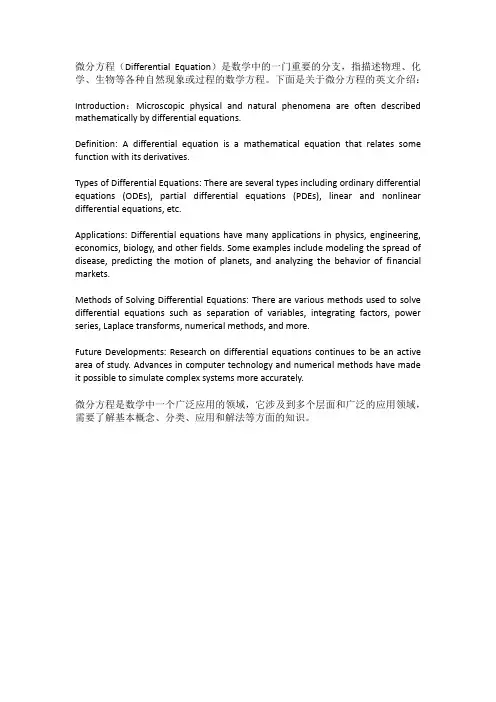
微分方程(Differential Equation)是数学中的一门重要的分支,指描述物理、化学、生物等各种自然现象或过程的数学方程。
下面是关于微分方程的英文介绍:Introduction:Microscopic physical and natural phenomena are often described mathematically by differential equations.Definition: A differential equation is a mathematical equation that relates some function with its derivatives.Types of Differential Equations: There are several types including ordinary differential equations (ODEs), partial differential equations (PDEs), linear and nonlinear differential equations, etc.Applications: Differential equations have many applications in physics, engineering, economics, biology, and other fields. Some examples include modeling the spread of disease, predicting the motion of planets, and analyzing the behavior of financial markets.Methods of Solving Differential Equations: There are various methods used to solve differential equations such as separation of variables, integrating factors, power series, Laplace transforms, numerical methods, and more.Future Developments: Research on differential equations continues to be an active area of study. Advances in computer technology and numerical methods have made it possible to simulate complex systems more accurately.微分方程是数学中一个广泛应用的领域,它涉及到多个层面和广泛的应用领域,需要了解基本概念、分类、应用和解法等方面的知识。
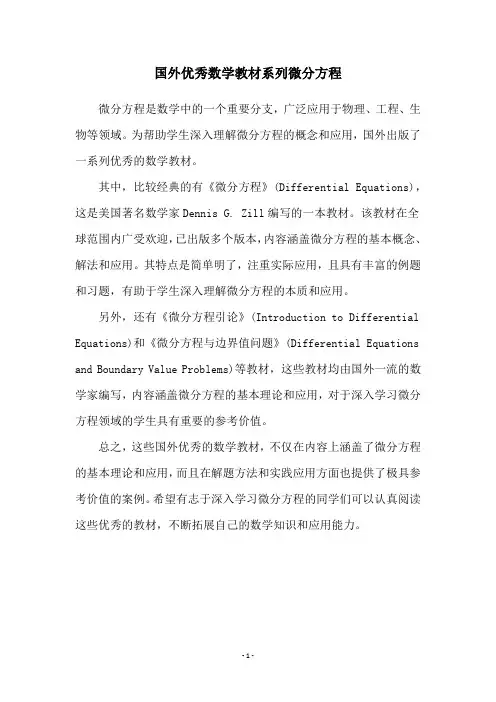
国外优秀数学教材系列微分方程
微分方程是数学中的一个重要分支,广泛应用于物理、工程、生物等领域。
为帮助学生深入理解微分方程的概念和应用,国外出版了一系列优秀的数学教材。
其中,比较经典的有《微分方程》(Differential Equations),这是美国著名数学家Dennis G. Zill编写的一本教材。
该教材在全球范围内广受欢迎,已出版多个版本,内容涵盖微分方程的基本概念、解法和应用。
其特点是简单明了,注重实际应用,且具有丰富的例题和习题,有助于学生深入理解微分方程的本质和应用。
另外,还有《微分方程引论》(Introduction to Differential Equations)和《微分方程与边界值问题》(Differential Equations and Boundary Value Problems)等教材,这些教材均由国外一流的数学家编写,内容涵盖微分方程的基本理论和应用,对于深入学习微分方程领域的学生具有重要的参考价值。
总之,这些国外优秀的数学教材,不仅在内容上涵盖了微分方程的基本理论和应用,而且在解题方法和实践应用方面也提供了极具参考价值的案例。
希望有志于深入学习微分方程的同学们可以认真阅读这些优秀的教材,不断拓展自己的数学知识和应用能力。
- 1 -。
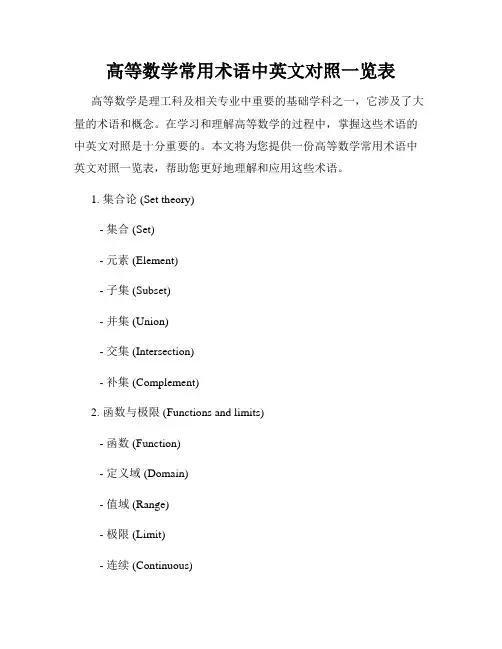
高等数学常用术语中英文对照一览表高等数学是理工科及相关专业中重要的基础学科之一,它涉及了大量的术语和概念。
在学习和理解高等数学的过程中,掌握这些术语的中英文对照是十分重要的。
本文将为您提供一份高等数学常用术语中英文对照一览表,帮助您更好地理解和应用这些术语。
1. 集合论 (Set theory)- 集合 (Set)- 元素 (Element)- 子集 (Subset)- 并集 (Union)- 交集 (Intersection)- 补集 (Complement)2. 函数与极限 (Functions and limits)- 函数 (Function)- 定义域 (Domain)- 值域 (Range)- 极限 (Limit)- 连续 (Continuous)- 偏导数 (Partial derivative)- 微分 (Differential)3. 微积分 (Calculus)- 导数 (Derivative)- 积分 (Integral)- 不定积分 (Indefinite integral)- 定积分 (Definite integral)- 曲线的长度 (Arc length)- 曲线的曲率 (Curvature)- 泰勒级数 (Taylor series)4. 微分方程 (Differential equations)- 微分方程 (Differential equation)- 一阶常微分方程 (First-order ordinary differential equation)- 齐次方程 (Homogeneous equation)- 非齐次方程 (Non-homogeneous equation)- 二阶线性常微分方程 (Second-order linear ordinary differential equation)- 高阶常微分方程 (Higher-order ordinary differential equation)5. 线性代数 (Linear algebra)- 行列式 (Determinant)- 向量 (Vector)- 矩阵 (Matrix)- 线性变换 (Linear transformation)- 特征值与特征向量 (Eigenvalue and eigenvector)- 正交 (Orthogonal)- 对称矩阵 (Symmetric matrix)6. 概率论与数理统计 (Probability theory and mathematical statistics) - 概率 (Probability)- 随机变量 (Random variable)- 概率密度函数 (Probability density function)- 累积分布函数 (Cumulative distribution function)- 期望值 (Expectation)- 方差 (Variance)- 正态分布 (Normal distribution)7. 多元函数 (Multivariable functions)- 偏导数 (Partial derivative)- 梯度 (Gradient)- 雅可比矩阵 (Jacobian matrix)- 多元微积分 (Multivariable calculus)- 多元函数积分 (Multiple integrals)- 曲面积分 (Surface integral)- 空间曲线积分 (Line integral in space)8. 级数 (Series)- 级数 (Series)- 收敛 (Convergence)- 绝对收敛 (Absolutely convergence)- 条件收敛 (Conditionally convergence)- 无穷级数 (Infinite series)- 幂级数 (Power series)- 泰勒级数 (Taylor series)以上仅为高等数学中的一小部分常用术语,但对于初学者来说,理解和掌握这些术语是基础的一步。
微分方程的通解包含了所有的解微分方程(Differential equations)是数学中的一个重要概念,广泛应用于物理、工程、经济等领域。
为了解微分方程,我们首先需要了解什么是微分方程以及它的通解。
微分方程是包含一个未知函数及其导数的等式。
一般地,微分方程可以通过对未知函数及其导数进行多次求导和代数运算,得到一个关系式。
根据这个关系式,我们可以求解出未知函数的表达式,这个表达式就是微分方程的解。
在微分方程的解中,有一个特殊的解称为特解(Particular solution),它满足方程的初始条件。
特解只能满足特定的初始值条件,不能满足其他初始值条件。
除了特解外,还存在一个更为一般的解集,称为通解(General solution)。
通解可以包含所有可能的解。
通解的求解方法有多种,其中一种常见的方法是利用分离变量法。
这种方法的基本思想是将微分方程的未知函数与其自变量进行分离,即将方程两边分别关于未知函数和自变量进行积分。
通过这种方法,我们可以将微分方程转化为一个代数方程,从而求解出未知函数的解析表达式。
以一阶线性常微分方程为例,假设我们要求解的微分方程为:dy/dx = f(x, y)其中f(x,y)是已知的函数。
我们首先将方程变形为:dy = f(x, y)dx然后将上式两边关于y和x进行积分:∫1/g(y)dy = ∫f(x, y)dx其中,g(y)是关于y的一个积分系数。
然后,我们可以对上式的两边求积分,得到:∫1/g(y)dy = ∫f(x, y)dx = Φ(x, y)其中Φ(x,y)是关于x和y的任意常数函数。
由于Φ(x,y)是任意常数函数,因此它包含了所有的解。
这就是微分方程的通解。
在求解微分方程时,也可以通过变量替换等方法将微分方程转化为更简单的形式。
例如,对于一阶齐次线性微分方程:dy/dx + P(x)y = 0我们可以通过变量替换y=u/v,将方程转化为一个变量可分离的方程。
微分方程式 (Differential Equations)微分方程式微分方程式: 方程式或等式中含有自變數之未知函數及其導函數或微分者稱之函數(因變數)y = f (x ); x :自變數 ⇒ 一般式或通式()0,=y x Fwhere ()()x f y y x F -=,函數的微分(differential) dy : 代表函數y 隨著自變數x 之變化―∆x ,而變化之∆y 的線性主部dx dxdy dy =()()dx x y x dy '=函數的導函數(derivative)()()xx y x x y x y dx dy y x x ∆-∆+=∆∆=='→∆→∆00lim lim※ 一個函數的自變量的增量∆x 趨近某一極限時,其因變量的增量∆y 與自變量的增量∆x 之商的極限※ 函數y 對自變數x 之瞬間變化率(instantaneous rate of change); 函數y 的無窮小的變化量dy (微分) 相對自變數x 的無窮小的變化量dx (微分)()()x y x x y y -∆+≡∆ ⇒()()εε+∆'=+=∆x x y x dy ydx x =∆⇒ ()ε+'=∆dx x y y()()⎩⎨⎧P.D.E. Equations, al Differenti Partial O.D.E. Equations, al Differenti Ordinary 偏微分方程式常微分方程式微分方程式常微分方程式(ordinary differential equation ,簡稱ODE )是只含有一個自變數的函數及它們的一個或多個導函數的微分方程式偏微分方程式指含有兩個或兩個以上自變數的函數及及其偏導數的方程式定義 一n 階常微分方程式通式如 ()()0,,,,='''n y y y y x F ()()0,,,='⇒='y y x F y x f ywhere ()()y x f y y y x F ,,,-'='()()()()()()()0,,,=-+'+''='''⇒=+'+''x f y x b y x a y y y y x F x f y x b y x a y()()()()()一階一次常微分方程式三階二次常微分方程式二階一次常微分方程式一階一次常微分方程式01413cos 62215252223322=-+=++⎪⎪⎭⎫ ⎝⎛+⎪⎪⎭⎫ ⎝⎛=+'+''=+dy y dx xe e t x dt x d dt x d x y y y y xy dxdy xt()0115522=-+⇒=-+y xe dx dy dy y dx xe xx 階(order): 微分方程式中出現之最高微分數稱為此微分方程式之階數次(degree): 微分方程式化成有理整式後,最高階微分相之最高幕次,稱為此微分方程式之次數線性常微分方程式 (linear ordinary differential equation): 微分方程式中自變數的函數(因變數) 及其導數的幕次均為一次方且無相互乘積項非線性常微分方程式 (nonlinear ordinary differential equation): 不屬於常線性微分方程式者均屬之()()()()()非線性常微分方程式非線性常微分方程式線性常微分方程式非線性常微分方程式01413cos 62215252223322=-+=++⎪⎪⎭⎫ ⎝⎛+⎪⎪⎭⎫ ⎝⎛=+'+''=+dy y dx xee t x dt x d dt x d x y y y y xy dxdy x t常微分方程式可表為下列通式者稱為線性常微分方程式()()()()()()()x R y x a y x a y x a y x a n n n n =+'+++--0111 1. ()n y y y y ,,,'''均為一次方且無乘積項 2. 無y 與其導數的非線性函數存在,()y e y y ,,sin3. ()()()()()x R x a x a x a x a n n ,,,,,011 -只為自變數的函數或常數齊次微分方程式 (homogeneous differential equation): R (x ) = 0 非齊次微分方程式 (inhomogeneous differential equation): R (x ) ≠ 0()()分方程式二階一次非線性齊次微式一次線性齊次微分方程三階0cos 0cos sin 32222332=++=+-y dxdydx y d y t dt y d t dt y d t微分方程式的解定義 一n 階微分方程式在區間(a , b )的解為在區間(a , b )滿足該微分方程式之一n 次可微分函數定義 一n 階微分方程式()()0,,,,,='''n y y y y x F 在某區間I 的解,為定義在區間I 並滿足該()()()()()()I x x x x x x F n ∈∀=''',0,,,,,φφφφ 之一n 次可微分函數()x φ證明函數()12-=x x φ為微分方程式22+=y dxdyx在區間∞<<∞-x 之解()()⎩⎨⎧'→='→-=y xx y x x 212φφ 02222=--⇒+=y dxdyxy dxdyx ()()02222212222222=-+-=---=--x x x x x y dxdyx∴()12-=x x φ為微分方程式22+=y dxdyx在區間∞<<∞-x 之解證明函數()x x x x y ln 22/12/1-=為微分方程式042=+''y y x 在區間()∞,0之解()x x x x x x x x x x x x y ln 21ln 21ln 212122/12/12/12/112/12/12/1--------=--=⎪⎭⎫⎝⎛+-='()2/32/312/12/321ln 41ln 2121------=⎪⎭⎫ ⎝⎛+--=''x x x x x x x x y()()()⎪⎪⎪⎩⎪⎪⎪⎨⎧-=''-='-=---2/32/32/12/12/121ln 41ln 21ln 2x x x x y x xx y x x x x yln 22ln ln 221ln 41442/12/12/12/12/12/12/32/322=-+-=-+⎪⎭⎫⎝⎛-=+''--x x x x x x xx x x x x x y y x ∴ 函數()x x x x y ln 22/12/1-=為微分方程式042=+''y y x 在區間()∞,0之解證明函數()x x y ln =為微分方程式022=+dx dydxy d x 在區間()∞,0之解, 但在區間()∞∞-,則不為其解()x x y ln =的定義域為()∞,00111111222222=+-=+⎪⎭⎫ ⎝⎛-=+⇒⎪⎪⎩⎪⎪⎨⎧-==x x xx x dx dy dx y d x x dxyd x dx dy∴ 函數()x x y ln =為微分方程式022=+dx dydxy d x 在區間()∞,0之解 ∵對數函數在區間()0,∞-無定義⇒函數()x x y ln =不為微分方程式022=+dx dydxy d x 在區間()∞∞-,之解顯函數解: 一n 階微分方程式其解可表為下列形式者,稱之()0,,,,,210==n c c c c x f y隱函數解: 一n 階微分方程式其解需表為下列形式者,稱之()()0,0,,,,,,,210=⇔=y x c c c c y x F n φ一般而言, 線性常微分方程式所得到的解,大多可表為顯函數解. 非線性常微分方程式所得到的解,大多為隱函數解. 證明函數0ln 2=--x y xy 為微分方程式122--=xy y xy dx dy 之隱函數解將0ln 2=--x y xy 對x 隱微分⇒ ()()0210ln 2=--+⇒=--x dxdyy dx dy xy dxdx y xy dx d ∴y x dxdyy xy y x dx dy y x -=-⇒-=⎪⎪⎭⎫ ⎝⎛-2121⇒ ()12122--=--=xy y xy xy y x y dx dy ∴ 函數0ln 2=--x y xy 為微分方程式122--=xy y xy dx dy 之隱函數解通解(general solution): 包含n 個任意常數的n 階常微分方程式的解.一般而言, n 階常微分方程式的解所包含任意常數的數目等於該微分方程式的階數. 特解(particular solution): 解中之常數均為定值或將初始條件或邊界條件帶入通解,決定任意常數的值,所得的解稱之.奇異解(singular solution): 不能由通解初始條件或邊界條件得到,但仍能滿足原微分方程式的解稱之.一階微分方程式之通解()()0 ,==x,y,c F c x f y 或c 為任意常數+ (初始)條件(initial condition) : ()00y x y = ⇒ 特解,c 為定值x 0,y 0為已知值一階微分方程式之圖形特解為積分曲線(integral curve),通解則稱積分曲線族,因c 為任意常數,可得無限個積分曲線 微分方程式y x dxdy-=在區間()∞∞-,具有一通解x e c x y -+-=01,試就 0.2,0.1,5.0,0,100000====-=c c c c c 決定其特解,並會出其積分曲線xx x x e x y c e x y c e x y c x y c e x y c ----+-=⇒=+-=⇒=+-=⇒=-=⇒=--=⇒-=210.210.15.015.0101100000證明ct t t y +=ln 為微分方程式t ty y t 12=-'在區間()∞,0之通解()c t c t y ct t t y ++=++='⇒+=1ln 1ln ln012=--'⇒=-'t y y t t t y y t()()0ln ln ln 1ln =---++=-+-++=--'t ct t t ct t t t t ct t t c t t t y y t∴ct t t y +=ln 為微分方程式t ty y t 12=-'在區間()∞,0之通解試證明微分方程式()12+-=x y dx dy 具有下列之解: ⎪⎩⎪⎨⎧=+-=x y c x x y :1:0奇異解通解()200011111c x c x dx d dx dy c x x y ++=⎪⎪⎭⎫ ⎝⎛+-=⇒+-= ()()01122=---⇒+-=x y dx dy x y dxdy∴01c x x y +-=為微分方程式()12+-=x y dx dy 的通解x y =無法由通解01c x x y +-=得到, ∴為微分方程式之奇異解 若c 1與c 2為任意常數,試證x c x c y 2cos 2sin 21+=為微分方程式0422=+y dxyd的解⎪⎪⎩⎪⎪⎨⎧--=-=⇒+=x c x c dxyd x c x c dxdyxc x c y 2cos 42sin 42sin 22cos 22cos 2sin 21222121()()02cos 2sin 42cos 42sin 44212122=++--=+x c x c x c x c y dx yd∴函數x c x c y 2cos 2sin 21+=為微分方程式0422=+y dxyd 之解求函數4- 1,22x y x y c cx y =+=+=及與微分方程式02=-+⎪⎭⎫ ⎝⎛y dx dy x dx dy 之關係 (1) c dxdyc cx y =⇒+=2()0222=+-+=-+⎪⎭⎫ ⎝⎛cx c cx c y dx dy x dx dy⎩⎨⎧+=為任意常數滿足原微分方程式c c cx y 2 ⇒ 2c cx y +=為通解 (2) 11=⇒+=dxdyx y ()0112=+-+=-+⎪⎭⎫⎝⎛x x y dx dy x dx dy⎩⎨⎧=+=11c x y 滿足原微分方程式⇒ 1+=x y 為特解 (3) 242xdx dy x y -=⇒-=0424422222222=+-=⎪⎪⎭⎫ ⎝⎛--⎪⎭⎫ ⎝⎛-+⎪⎭⎫ ⎝⎛-=-+⎪⎭⎫ ⎝⎛x x x x x x x y dx dy x dx dy⎪⎩⎪⎨⎧-=無法由通解中得到不含任意常數滿足原微分方程式,42x y ⇒ 42x y -=為奇異解。
微分方程解法总结微分方程(Differentialequations)是数学中的一个主要分支,它用来描述变量之间的关系,而解微分方程则是数学中的一个重要技术。
它通过描述随时间和空间的变化,来模拟机械运动、物理运动、热传导、电磁场的变化、生物学和社会科学中的变化,来获得物理解释和数学模型。
解微分方程不仅是学习级别最高的领域,也是一个极具挑战性的任务。
微分方程解法解微分方程的方法有很多,通常可以分为三类:一是直接解法,如求解线性微分方程;二是近似解法,如有限差分等;三是数值解法。
1.接解法直接解法是利用有关微分方程的性质,利用其可积性,求出两种类型的方程的解:(1)线性微分方程:主要有常系数线性微分方程、齐次线性微分方程、常数项线性微分方程,以及模拟方程。
它们具有特定的结构,可以用整体解法求解,具体求解方法有分类积分法、拉普拉斯变换法、Laplace分变换法,等。
(2)非线性微分方程:此类方程又分为一阶非线性方程和多阶非线性方程,已有的解法有解析解、变量变换等。
2.似解法近似解法主要有有限差分方法和有限元方法,它们的基本思想是将复杂的微分方程分解为一系列简单的子问题,从而求解结果。
具体而言,它们各自做法如下:(1)有限差分方法:是一种利用数值计算技术求解微分方程的方法,其核心思想是利用微分方程的连续性,将微分方程拆分为一系列子问题,然后利用格点数值来求解。
其优点是求解简单,可以应用于多维情况;缺点是容易出现误差,精度也不够高。
(2)有限元方法:是一种求解微分方程的方法,其基本思想是,将微分方程的解空间分解为一系列有限元,然后利用数值技术求解有限元的解,从而获得微分方程的解。
它的优点是可以求解多维复杂情况,精度也较高;缺点是求解较为复杂,程序也较为复杂。
3.值解法数值解法是利用数值技术求解微分方程的方法,又分为测试法(欧拉法、梯形法、龙格库塔法等)和迭代法(牛顿法、拉夫法等)两类。
试方法利用微分方程的性质,将微分方程拆分为一系列简单子问题,然后利用数值解决方案求解;迭代方法利用迭代法不断接近最终解,无需事先拆分之类的步骤,可以得到较准确的解。
应用质点系运动微分方程的研究技术一、质点系运动微分方程的定义质点系运动微分方程是一种描述物体在特定的空间内的运动轨迹的数学方程。
它是一种描述物体运动的微分方程,可以用来求解物体在特定条件下的运动轨迹。
它是一种描述物体运动轨迹的一般微分方程,可以用来解决质点系的运动问题,它可以用来求解物体在特定条件下的运动轨迹。
质点系运动微分方程的定义是:当物体处于一定的空间中,它的运动轨迹可以用一个特殊的微分方程来描述,这个微分方程就是质点系运动微分方程。
它由一个或多个未知函数的求导与一个或多个已知函数的乘积组成,这些函数可以是时间函数、位置函数或速度函数等,只要它们满足物体运动的物理规律。
例如,用质点系运动微分方程来描述一个抛物运动的物体,可以得到一个如下的微分方程:\frac{d^2x}{dt^2}=-g,其中,g表示重力加速度。
又如,用质点系运动微分方程来描述一个摆动运动的物体,可以得到一个如下的微分方程:\frac{d^2x}{dt^2}=-\frac{g}{l}sin(x),其中,g表示重力加速度,l表示摆的长度。
总之,质点系运动微分方程是一种描述物体在特定的空间内的运动轨迹的数学方程,它由一个或多个未知函数的求导与一个或多个已知函数的乘积组成,它可以用来求解物体在特定条件下的运动轨迹。
二、质点系运动微分方程的常见形式质点系运动微分方程是一组常见的微分方程,它们描述了质点系的运动。
它们的形式是一般的欧拉方程,也就是一阶微分方程组,其中有n个未知函数,每个函数有m个变量。
它们的具体形式是:$$\frac{d \mathbf{x}}{dt} = \mathbf{f}(\mathbf{x},t)$$其中,$\mathbf{x}$ 是质点系的状态变量,$\mathbf{f}$ 是质点系的动力学方程,描述了质点系的运动规律。
质点系运动微分方程有许多不同的形式,比如牛顿运动方程,描述了质点受到外力时的运动规律:$$m \frac{d^2 \mathbf{x}}{dt^2} = \mathbf{F}(\mathbf{x}, t)$$这里,$m$ 是质量,$\mathbf{F}$ 是外力。
微分方程的种类范文微分方程是数学中的一种重要工具,用于描述物理、工程、经济等领域中的变化过程。
根据方程中未知函数、变量、阶数等不同特征,微分方程可以分为许多不同的类型。
本文将介绍常见的微分方程种类,包括常微分方程、偏微分方程、线性微分方程、非线性微分方程、一阶微分方程和高阶微分方程。
让我们开始吧。
1. 常微分方程(Ordinary Differential Equations, ODEs):常微分方程是指只涉及一个自变量的微分方程,未知函数只是这个变量的函数。
常微分方程的一般形式为f(x, y, y', ..., y(n)) = 0,其中y表示未知函数,y'表示一阶导数,y(n)表示n阶导数。
常微分方程可以进一步细分为线性、非线性、高阶和解析等类型。
2. 偏微分方程(Partial Differential Equations, PDEs):偏微分方程是指涉及多个自变量的微分方程,在方程中的未知函数是这些变量的函数以及它们的偏导数。
常见的偏微分方程包括热传导方程、波动方程和扩散方程等。
与常微分方程不同,偏微分方程通常需要通过边界条件或者初始条件来求解。
3. 线性微分方程(Linear Differential Equations):线性微分方程是指未知函数及其导数(包括一阶导数)之间的关系是线性的微分方程。
线性微分方程可以通过变量分离、参数替换等方法求解。
线性微分方程的求解方法较为简单,且具有很好的理论基础。
4. 非线性微分方程(Nonlinear Differential Equations):非线性微分方程是指未知函数及其导数(包括一阶导数)之间的关系是非线性的微分方程。
非线性微分方程的求解通常比较困难,需要借助数值计算或者近似方法。
5. 一阶微分方程(First-order Differential Equations):一阶微分方程是指只包含一阶导数的微分方程。
一阶微分方程通常可以通过分离变量、恰当积分常数、绝对值法等方法求解。